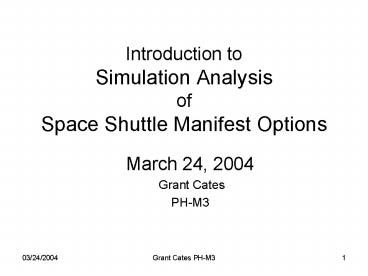Introduction to Simulation Analysis of Space Shuttle Manifest Options PowerPoint PPT Presentation
1 / 9
Title: Introduction to Simulation Analysis of Space Shuttle Manifest Options
1
Introduction toSimulation Analysis of Space
Shuttle Manifest Options
- March 24, 2004
- Grant Cates
- PH-M3
2
Discrete Event Simulation
- Discrete-event simulation is the modeling of a
system as it evolves over time by a
representation in which the state variables
change instantaneously at separate points in
time. Law and Kelton, Simulation Modeling and
Analysis. - For example, in a shuttle manifest model, a state
variable could be the location of the orbiter. - Location might initially be the OPF. At some
future point in time, the orbiter will change
from being in the OPF to being in transit to the
VAB. Likewise, it will then arrive at the VAB at
some later point in the future. - Discrete-event simulation modeling constructs
enable a wide variety of systems to be modeled.
Basic constructs include - seize a resource
- process for some length of time
- Release resource
- decision nodes,
- route to specified location,
- etc.
3
Applicable to Modeling Shuttle Manifests
- Discrete Event Simulation, (may also be called
Monte Carlo simulation) is an appropriate tool
for modeling shuttle manifests. - Allows us to capture the inherent complexities of
implementing space shuttle manifests. - Added work content growth in the OPF, VAB, or
launch pad etc. - Schedule delays to Orbiter, ET, RSRM, and SRB
etc, caused by PRACA. - Launch delays caused by weather or technical
problems - Dryden landings
- Provides a quantitative measure for our ability
to achieve future launches. - Enables sensitivity analysis on the system and
answers What-if type of questions concerning
the influence of input parameters. - Manifest planned work days and margin days in the
OPF, VAB, Launch Pad. - Number of launch pads, flight hardware assets,
launch restrictions.
4
Discrete Event Simulation Analysis Performed in
2003
- Node-2 Launch Date Assessment Model (January).
- Provided a quantitative assessment of the
likelihood that NODE-2 will launch on February
19, 2004 or subsequent dates. - Provide Shuttle Program with a tool for assessing
how proposed changes increase or decrease ability
to achieve the NODE-2 launch date. - Identified ways to increase probability of
achieving planned NODE-2 launch. - Presented to Space Shuttle Program Manager.
- SSME Engine Analysis Model (Summer/Fall)
- Showed the influence of SSME fleet size on
average annual flight rate. - Presented to Space Shuttle Program Manager.
- Launch Window Launch Probability Model (October)
- Determined the launch probability for various
launch window durations e.g. 3-day versus 5-day. - Presented to Space Shuttle Flight Operations and
Integration Office. - Comparison of Two Manifest Options (November)
- Analyzed likely HST Launch date given two
different manifest option each having the same
launch date.
5
(No Transcript)
6
Shuttle Flight Hardware Processing Model
7
Flow (OPF, VAB, Pad) Modeling Constructs
- Activities, such as OPF, VAB, and Pad flows, are
modeled as a combination of the planned activity
duration, reserve, and delta to planned duration,
as shown by the figure below. - The planned activity duration and available
reserve are inputs from the particular manifest
being modeled. - The delta to the planned duration is based on
history. - During simulation runs, as in real shuttle
processing, if the delta to the planned duration
can be absorbed by the reserve, then the activity
will finish on schedule. However, if the delta
exceeds the reserve, then the activity will
complete late.
8
Flow (OPF, VAB, Pad) Modeling Constructs (cont)
- The simulation logic includes checking for
completion of predecessor activities and
availability of required resources. - The simulation logic automatically reduces
reserve if the activity starts late.
9
Input Analysis and Simulation Results
- A detailed briefing on input analysis for shuttle
manifest simulation models is available in a
separate presentation. - Simulation results for specific simulation models
are available in separate presentations.

